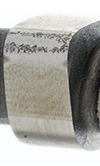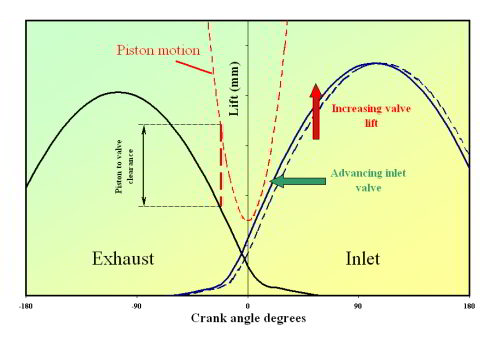Timing the piston
 In a good camshaft design the cam profile is but one half of the story. Lifting the valve off its seat and then opening fully before closing it again and dropping it gently back onto its seat requires a lot of careful mathematics and, executed well, should give the maximum valve area opening period for the minimum of forces involved. But just as much as efficient inlet and exhaust cam profiles are critical to any high performance engine, the timing of their opening and closing in relation to each other and in particular to that of the piston motion, can never be overstated.
In a good camshaft design the cam profile is but one half of the story. Lifting the valve off its seat and then opening fully before closing it again and dropping it gently back onto its seat requires a lot of careful mathematics and, executed well, should give the maximum valve area opening period for the minimum of forces involved. But just as much as efficient inlet and exhaust cam profiles are critical to any high performance engine, the timing of their opening and closing in relation to each other and in particular to that of the piston motion, can never be overstated.
Traditional reciprocating engine practice is to open the exhaust valve well before piston bottom dead centre. At this position most of the expansive power of the combustion on the piston crown has been spent and opening the valve at this time enables rapid evacuation of the cylinder. Also, opening the valve sufficiently early enables the exhaust gas to be swept out of the cylinder without creating too much back-pressure during the piston upward stroke and minimises pumping losses. Likewise on the next engine revolution, and with the exhaust valve closed, the inlet valve only closes well after bottom dead when attempts are made to harness the inertia of the intake air and trap as much of it in the cylinder as possible. However, it is around top dead centre on the non-firing stroke when things can get pretty hair-raising and the opportunity for a disaster begins!

First we have the intake valve at the point of opening. Beginning just before top dead centre the valve will be off its seat and moving ready to admit the intake charge in response to the piston downward motion. Somewhere shortly afterwards and slightly after top dead centre the exhaust valve will be coming to rest back on its seat. The time between the intake opening and exhaust valve closing is referred to the world over as the valve overlap, and a number of interesting possibilities could occur because amid all this lurks the piston crown. In a modern wide bore, short stroke engine, to produce a compact combustion chamber with a high compression ratio and with minimal surface to volume ratio, requires a high compression height to the piston at top dead centre such that the piston motion just misses the exhaust valve on its upward stroke and is almost collected by the intake valve on the downward stroke. It is clear therefore that once the valve-piston geometry is designed, even with small cut-outs in the piston crown, only slight adjustment of the valve timing may be possible. In particular, the higher the speed for which engine performance is optimised, the later the exhaust valve closure. Retarding the cam in this way risks the exhaust valve touching the piston on its closing leg. Likewise advancing the inlet cam chasing an even better torque characteristic, risks attacking the piston on its downward stroke.
As a double check when building prototype engines it was therefore always considered best to fit very light valve springs on the initial trial build so that around the piston top-dead-centre non-firing stroke, the valves could be pushed all the way down to contact the piston to determine the actual clearance. Although the minimum running clearance when hot will be slightly different, at least you will be able to build up an idea of where the limits to the valve timing reside.
In designing any camshaft profile therefore, due consideration has to be made not only to the cam duration required and the valve-to-combustion chamber geometry, but also to the practical aspects of the piston-to-valve clearance available.
Written by John Coxon.